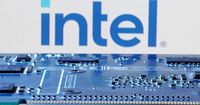In a move that could reshape the landscape of U.S. technology and industrial policy, the Trump administration is actively considering taking a direct equity stake in Intel, the nation’s leading semiconductor manufacturer. This initiative, first reported by Bloomberg on August 14, 2025, has sent shockwaves through financial markets and ignited a fierce national debate about the future of American industry, national security, and the role of government in the private sector.
Intel’s shares surged by more than 7% in regular trading and an additional 2.6% after the bell on the day the reports surfaced, reflecting investor optimism—or perhaps anxiety—about the prospect of government intervention (according to Reuters and BBC). The news comes at a critical time for Intel, which has recently seen its fortunes wane. Once the undisputed leader in chip manufacturing, Intel’s market value has plummeted from $288 billion in 2020 to just $104 billion by August 2025, with profit margins halved and its dominance in the AI chip sector overtaken by rivals like Nvidia (as reported by Al Jazeera and BBC).
The potential deal is centered on Intel’s delayed $28 billion chip fabrication plant in Ohio, a project originally announced in 2022 as a $20 billion investment but now pushed back at least five years, with completion expected between 2030 and 2031. This mega-factory was touted as a cornerstone for U.S. technological independence, but repeated delays and cost overruns have cast doubt on its future. The Trump administration sees shoring up this facility as vital to maintaining America’s edge in high-end semiconductor manufacturing, especially as global competitors like TSMC and Samsung surge ahead (as explained by Fortune and BBC).
The talks between the federal government and Intel reportedly began after a high-stakes meeting between President Donald Trump and Intel’s CEO, Lip-Bu Tan, earlier this month. Tan, an American venture capitalist who took over as CEO in March 2025 following the board’s ousting of Pat Gelsinger, has been tasked with steering the company through turbulent waters. His tenure has not been without controversy: just days before the meeting, Trump publicly called for Tan’s resignation over his past investments in Chinese tech companies, some allegedly linked to the Chinese military. Trump later described their face-to-face as “very interesting,” adding that Tan has “an amazing story” (according to Bloomberg and Fortune).
Despite the public drama, Intel has maintained a diplomatic stance. The company declined to comment directly on the reports, but stated it was “deeply committed to supporting President Trump’s efforts to strengthen U.S. technology and manufacturing leadership.” The White House, too, has treaded carefully, with spokesman Kush Desai cautioning that “discussion about hypothetical deals should be regarded as speculation unless officially announced by the administration” (as reported by BBC, Reuters, and Al Jazeera).
What makes this potential intervention so remarkable is its departure from decades of U.S. industrial policy. Traditionally, support for domestic chipmakers came in the form of grants and subsidies, such as those allocated under the CHIPS Act. Trump’s approach, however, appears to favor direct government equity stakes—an idea more commonly associated with state capitalism abroad than with American free-market tradition. This echoes recent White House moves, such as taking a “golden share” in U.S. Steel and the Department of Defense’s $400 million preferred share purchase in rare-earth miner MP Materials (according to Fortune and Reuters).
According to people familiar with the discussions, the administration is considering using funds from the CHIPS Act to at least partially finance the equity stake in Intel. Options on the table include converting some or all of Intel’s existing CHIPS Act grants into equity or combining new funding with other financing streams (as reported by Bloomberg on August 15, 2025). The size and terms of the government’s potential stake remain unclear, with sources emphasizing that talks are still in their early stages.
For Intel, the stakes are existential. The company’s foundry business, which aims to manufacture chips for other firms, has struggled to land major clients, and its inability to keep pace in the booming AI chip industry has left it “cash poor,” according to former CEO Craig Barrett. Barrett, writing in Fortune, estimated that Intel would need a cash infusion of roughly $40 billion to remain competitive, stating bluntly, “Realistically that investment is 100% of the [CHIPS] Act Capital grants so unlikely the [U.S. government] is the savior.” Four former Intel directors have also weighed in, advocating for a separation of Intel’s critical foundry business, which they argue is essential for national security.
Industry analysts are divided over the wisdom of a direct government stake. David Nicholson of The Futurum Group described the move as a potential “lifeline” for Intel, while Austin Lyons argued it would be a “special case” justified by the strategic importance of U.S. chipmaking. Others, like Raymond Woo of Kyoto University Innovation Capital, caution that government backing is risky given Intel’s lag behind global rivals and suggest support could be spread among other American semiconductor firms as well (as reported by BBC).
Not everyone is convinced that direct intervention is necessary. Despite Intel’s recent stumbles, the company still boasts annual revenues exceeding $50 billion, and some investors question whether it truly needs such aggressive government assistance (as noted by Reuters). Yet, with Washington increasingly viewing advanced chip manufacturing as a matter of national security, the argument for intervention has gained traction. The administration’s recent deal with Nvidia and AMD, requiring them to pay 15% of Chinese revenues to the U.S. government in exchange for resuming exports of banned AI chips, signals a broader willingness to intertwine government and private enterprise in service of strategic goals.
The potential government stake in Intel is emblematic of a larger shift in how the U.S. is approaching its industrial future. Supporters see it as a necessary step to ensure technological independence and economic growth, especially as rival nations pour resources into their own chip industries. Critics, meanwhile, warn of the dangers of government picking winners and losers, and question whether such interventions can truly restore American leadership in semiconductors.
As discussions continue behind closed doors, the outcome remains uncertain. What is clear, however, is that the fate of Intel—and by extension, America’s technological edge—hangs in the balance. The coming months will reveal whether a bold new partnership between government and industry can revive a storied American company and secure the nation’s place at the forefront of global innovation.



